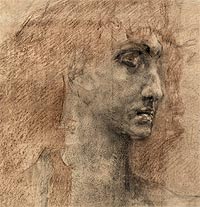Irina Shumanova

CURRENT EXHIBITIONS
Irina Shumanova
Vrubel: an Artist for the Ages
#3 2021 (72)
Mikhail Vrubel (1856-1910) holds a unique place in the history of Russian art. On the one hand, he belonged to the legendary cohort of Russian Art Nouveau artists. According to his contemporaries, it was in his oeuvre that “we find the saddest and most beautiful artistic expression of the time” In a newspaper article on the occasion of Vrubel’s funeral, the celebrated Russian artist and art historian Alexandre Benois predicted: “Future generations, should true enlightenment shine upon the Russian public, will look back at the last decades of the 19th century as ‘the era of Vrubel’.” Nevertheless, there is clearly a great gap between Vrubel and his artistic milieu: he seems to be much more in touch with the future than with the world around him. “Here is what I do know: I can only stand in awe of the mysteries that Vrubel and others like him begin to reveal to mankind once in 100 years. We are unable to see the worlds that were open to them, and so all we can do is utter this feeble, indifferent word: ‘genius’.

HERITAGE
Irina Shumanova
Golovin and Diaghilev. Pro et contra
#3 2014 (44)
ON OCTOBER 2 1921 IN PETROGRAD, STRAVINSKY'S BALLET "THE FIREBIRD", DESIGNED BY ALEXANDER GOLOVIN, PREMIERED AT THE ACADEMIC THEATRE OF OpERA AND Ballet (Formerly The MARIINSKY Theatre). IT WAS The Finale OF A CONFUCT, BETWEEN The IMPERIAL THEATRES AND SERGEI DIAGHILEV'S COMPANY, WHICH HAD BEEN RUNNING THROUGH THE 1910S - A CONFRONTATION IN WHICH GOLOVIN PLAYED AN IMPORTANT AND COMPLICATED ROLE, ACTING AS DIAGHILEV'S ASSOCIATE AND, AT THE SAME TIME, CHALLENGER.

CURRENT EXHIBITIONS
Yevgenia Ilyukhina, Irina Shumanova
Sergei Diaghilev's "Ballets Russes" on the Tretyakov Gallery Stage
#3 2013 (40)
Sergei Diaghilev occupies a special place in the culture of the 20th century – many publications have analysed his personality and artistic projects. But who can state that the puzzle of Diaghilevʼs infinite creativity has been unriddled. For many, he is not so much a real person as a composite figure of the ideal impresario, in whom the talent of an organizer was married to an exceptional sensitivity and receptivity to any innovation in art and, of course, the faculty for finding like-minded individuals and financing for his projects.
|
|
CURRENT EXHIBITIONS Irina Shumanova, Yevgeniya Ilyukhina #3 2012 (36) The exhibition "The Basic Materials of Graphic Art: Paper and Wood, Silk and Glass..." features items from the Tretyakov Gallery's collection of drawings of the 18th-early 20th centuries. It is the final show in a series devoted to drawing materials, media and techniques used in Russia, and is intended to introduce to the public the history and diversity of the materials used in graphic art. The word traditionally applied to them in Russia — "the foundation" — most aptly characterises their role in the creation of an artwork, that of a "tuner" directing the artist towards a certain drawing style. The choice of material to a large extent determines how strokes or dabs of colour are applied — their tempo, rhythm, energy, and density. The exhibition is thematically arranged, exploring different kinds of materials and their characteristics such as structure, texture of the surface, colour, and tone. |
|
|
CURRENT EXHIBITIONS Irina Shumanova, Yevgenia Ilyukhina #1 2011 (30) of an idea and the stages of its further development. But drawing also has a life of its own as an independent art form with a distinctive language, specific rules and history. Pencils come in many different varieties – silver, lead, graphite, black chalk, wax, coloured pencils, lithographic pencils and other types – and the word also refers to a large number of similar media which can be categorized as the techniques of “dry drawing”, like charcoal, sanguine and sauce. There is an almost limitless variety of techniques involving the use of these materials, and they serve to show off a particular artistÕs individuality, sense of form, innate talent and level of skills. A drawing in pencil, charcoal, sanguine or sauce is the best reflection of its creatorÕs temperament and character. From the vast variety of pencil and pencil-related techniques every epoch chooses those that suit it best. The age of classicism treasured the austere beauty of linear drawing, romanticism – the contrasts and the picturesque quality of strokes; for the “Peredvizhniki” (Wanderers) artists, pencils were “modest workers”, and the modernist movement re-invented the selfsufficiency of lines and the aesthetic value of the process of drawing as such. |
|
|
CURRENT EXHIBITION Evgenia Ilyukhina, Irina Shumanova #3 2009 (24) Sergei Diaghilev occupies a special place in the culture of the 20th century – many publications have analysed his personality and artistic projects. But who can state that the puzzle of Diaghilevʼs infinite creativity has been unriddled. For many, he is not so much a real person as a composite figure of the ideal impresario, in whom the talent of an organizer was married to an exceptional sensitivity and receptivity to any innovation in art and, of course, the faculty for finding like-minded individuals and financing for his projects. |
|
|
CURRENT EXHIBITIONS Irina Shumanova #3 2008 (20) The exhibition of watercolours from the 18th to early 20th centuries from the Tretyakov Galleryʼs Department of graphic art. |
|
|
ART COLLECTORS AND PATRONS Irina Shumanova, Yevgenia Ilukhina #3 2007 (16) Over the last ten years the Tretyakov Gallery has been displaying drawings from its collections at temporary exhibitions. The exhibition programme has had a continuous focus on the history of the collection of 18th–20th century drawings. The gallery’s 20th exhibition in the series reflects a new stage in the history of its collection – namely, the significant enlargement of the collection in the first decade following the Bolshevik revolution due to new acquisitions from private Moscow collections. |














